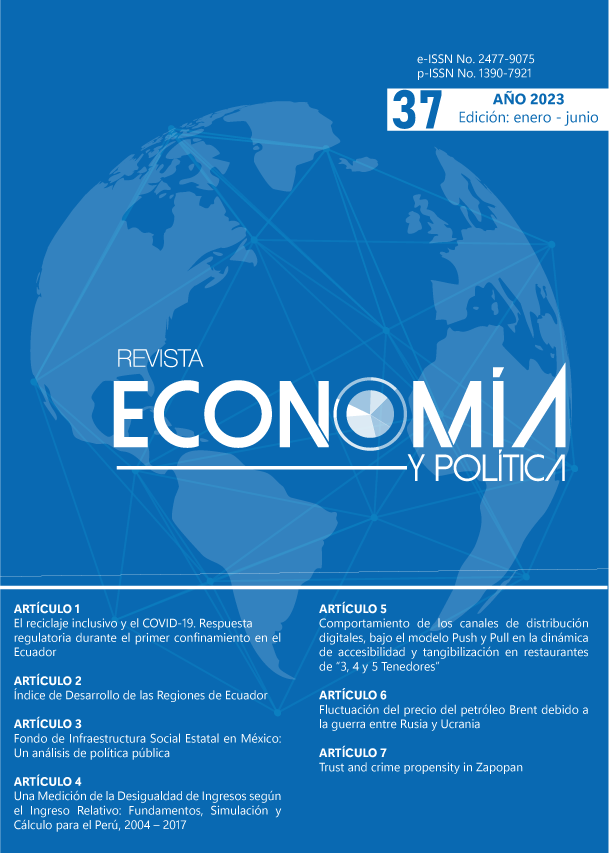Trust and crime propensity in Zapopan
DOI:
https://doi.org/10.25097/rep.n37.2023.07Palabras clave:
Propensión al crimen, Desconfianza, Confianza generalizada, Confianza socialResumen
El objetivo de esta investigación es señalar que la confianza generalizada es uno de los factores asociados a la propensión a la delictiva desde una perspectiva sociológica. De ahí que se realizó una encuesta presencial a 400 hogares del municipio mexicano de Zapopan, Jalisco; para conocer su percepción sobre distintas realidades sociales, entre estas, su nivel de confianza social y su propensión a infringir la ley. A través de modelos logit se encuentra que la educación y la edad tienen una relación negativa con la intención de cometer un crimen, mientras que las variables corrupción y desconfianza tienen una asociación positiva.
Descargas
Citas
Agnew, R. (1992). Foundations for a General Strains Theory. Criminology, 30(1), 47–87.
Bjørnskov, C. (2006). Determinants of generalized trust : A cross-country. Public Choice, 130, 1–21. https://doi.org/10.1007/s11127-006-9069-1
Bouffard, J. A., & Muftic, L. R. (2006). Program Completion and Recidivism Outcomes Among Adult Offenders Ordered to Complete a Community Service Sentence. Journal of Offender Rehabilitation, 43(2), 1–33.
Ciobanu, D. M. (2019). Social Disorganization Theory : The Role of Diversity in New Jersey ’ s Hate Crimes Based on Race and Ethnicity. Journal of Social, Behavioral and Health Sciences, 13(1), 15–37. https://doi.org/10.5590/JSBHS.2019.13.1.02
Consejo Nacional de Población (CONAPO). (2020). Proyecciones de la Población de los Municipios de México, 2015-2030 (base 1). Retrieved from https://datos.gob.mx/busca/dataset/proyecciones-de-la-poblacion-de-mexico-y-de-las-entidades-federativas-2016-2050/resource/751728c1-e0cf-4fe8-b0fb-55b17d22bac4
Deller, S. C., & Deller, M. A. (2010). Rural Crime and Social Capital. Growth and Change, 41(2), 221–275.
Ehrlich, I. (1975). The deterrent effect of capital punishment: a question of life and death. American Economic Review, 65(3), 397–417.
Fukuyama, F. (1995). Trust: The social virtues and the creation of prosperity. N.Y.: The Free Press.
Gottfredson, M., & Hirshi, T. (1990). A General Theory of Crime. Stanford, CA: Stanford University Press.
Hagan, J. (1992). The poverty of a classless criminology. Criminology, 30(1), 1–18.
Hampson, F. O. (2013). Human Security. In D. Williams (Ed.), Security Studies: An introduction (pp. 279–295). New York: Routledge.
Instituto de Información Estadística y Geográfica (IIEG). (2018). ZAPOPAN DIAGNÓSTICO MUNICIPAL Mayo 2018.
Listokin, Y. (2005). Future-Oriented Gang Members? Gang Finances and the Theory of Present-Oriented Criminals. American Journal of Economics and Sociology, 64(4), 1073–1083.
Merton, R. (1968). Social Theory and Social Structure. N.Y.: Free Press.
Moore, M. D. (2019). Social Disorganization Theory and Suicide. International Social Science Journal, 69(231), 5–14.
North, D. C. (1990). Institutions, Institutional Change and Economic Performance. Cambridge: Cambridge University Press.
Putnam, R. (1993). Making Democracy Work: Civic Traditions in Modern Italy. Princeton, N.J.: Princeton University Press.
Rock, P. (2012). Sociological Theories of Crime. In M. Maguire, M. Morgan, & R. Reiner (Eds.), Oxford Handbook of Criminology (pp. 39–81). Oxford: Oxford University Press.
Secretariado Ejecutivo del Sistema Nacional de Seguridad Pública (SESNSP). (2020a). Cifras de Incidencia Delictiva Municipal, 2015 - mayo 2020. Retrieved July 14, 2020, from https://drive.google.com/file/d/14fDk5sBry1DOo9CqAs6KU84mp9ktSanG/view
Secretariado Ejecutivo del Sistema Nacional de Seguridad Pública (SESNSP). (2020b). Número de delitos por cada 100 mil habitantes. Retrieved July 14, 2020, from https://drive.google.com/file/d/1q8AdhfxpLdF_l8w082qE4T020EkJ4I2J/view
Sheley, E. (2018). A Broken Windows Theory of Sexual Assault Enforcement. Journal of Criminal Law and Criminology, 108(3), 455–511.
Stolle, D. (2002). Trusting Strangers-The concept of Generalized Trust in Perspective. Osterreichische Zeitschrift Für Politikwissenschaft, 31(4), 397–412.
Tappan, P. W. (2001). Who is the criminal? In S. Henry & M. Lanier (Eds.), What is Crime? Controversies over the Nature of Crime and What to Do About It (pp. 27 – 37). United States of America: Rowman & Littlefield Publishers.
Williams, P. (2013). Security Studies: An introduction. In P. Williams (Ed.), Security Studies: An introduction (pp. 1–13). New York: Routledge.
Yamada, T., Yamada, T., & Kang, J. (1993). Crime rate and labor market conditions: Theory and Time-series Evidence. Economics Study Quarterly, 44(3), 250–262.
Descargas
Publicado
Cómo citar
Número
Sección
Licencia
Derechos de autor 2023 Revista Economía y Política

Esta obra está bajo una licencia internacional Creative Commons Atribución-NoComercial-CompartirIgual 4.0.






